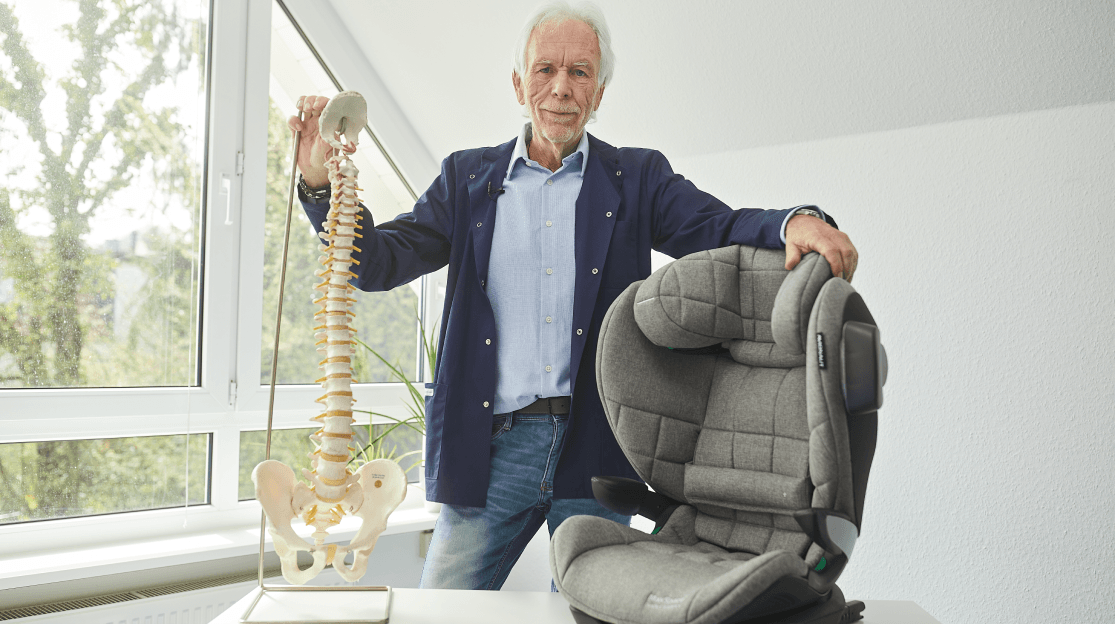
The seat and the child’s spine
When choosing a car seat for your child, you pay attention to e.g. the results of safety tests, the way the seat is fitted or the way it adjusts to the particular height and weight of your child. However, most parents overlook one critical issue – the specific position in which the child sits during the trip and its effect on the child’s spine. What should be kept in mind in this case? Is it good for the child to ride for many hours in the car seat, or on the contrary? What are the recommendations of physiotherapists and paediatricians? The answers to these questions are included in the following entry.

Contents:
- What is the correct development of a toddler’s spine?
- Semi-sitting position in a car seat and distorted development of spinal curvature
- MaxSpace Comfort System+ from Avionanut – spine protection at the highest level
What is the correct development of a toddler’s spine?
Before we move on to the impact of car seats on children’s spines, it is worth focusing on their optimal development. This is not common knowledge, but it is undoubtedly useful as it allows us to look at the whole issue from broader perspective.
The child’s spine develops gradually according to the stages during which the child strengthens its muscles, increases the mobility of its joints, learns completely new movements and assumes new positions. Three terms are key here: cervical lordosis, thoracic kyphosis and lumbar lordosis.
- Cervical lordosis is a forward curvature of the spine in the cervical region. It is possible approx. three months of age, when the baby is able to raise its head higher and higher while lying on its stomach.
- Thoracic kyphosis – is a backward curve of the spine in the thoracic region. It develops from around 6 to 10 months of age while learning to sit up unassisted.
- Lumbar lordosis – is a forward curve of the spine in the lumbar region. It develops from the 6th to the 10th month of life when the baby starts to crawl. Then it deepens while the baby is standing (from the 10th to the 14th month) and while learning to walk (from the 12th to the 18th month).
Semi-sitting position in a car seat and distorted development of spinal curvature
Nowadays, nobody doubts the necessity of using car seats. They are the ones that make it possible to comfortably transport the little ones in the car and guarantee them maximum safety during unexpected road accidents. However, the word “car” does not appear in the name of car seats for a reason.
This means that they should be used sparingly and only when absolutely necessary, i.e. when you are travelling by car. Unfortunately, some parents seem to forget about this and treat the car seat as a universal accessory, i.e. a carrycot and a cradle in one. This, in turn, can hurt the development of the child’s spine and optimal posture.
In addition, toddlers who are too often carried in car seats are able to see more than when lying on their stomachs or backs. This, in turn, causes that already a few months old baby will try to pull itself up when you grasp its hands. Some parents misinterpret this as readiness to sit down and therefore happily place their baby on a chair or on their lap. Unfortunately, this is a big mistake: the abdominal and back muscles are not yet sufficiently developed in such a tiny baby, so they cannot actively maintain a vertical position and therefore sit asymmetrically. Because of this, the spinal asymmetries are preserved, the risk of developing posture defects increases, and the work of internal organs is disturbed. What are the recommendations of professionals regarding the use of child seats?
- The child should stay in the car seat for a maximum of 2 hours a day.
- The seat should be shaped in such so as to make it easier for the child to hold its head (without falling chest first). This positioning improves the baby’s breathing mechanics (the diaphragm is not under pressure from the internal organs) and reduces gastric retractions’ frequency, which minimises the risk of vomiting during travel.
- The child’s head should be secured at the sides but without blocking the shoulders.
- The pelvis, torso and head must be in a straight line.
- Do not add extra accessories to the seat to make it more comfortable for the child (e.g. pillows).
- Ensure that the child’s car seat is correctly and firmly installed in the car – only then will it fulfil its function.
- Make sure the seat is suitable for your child; check what safety tests it has undergone and what standards it meets.
MaxSpace Comfort System+ from Avionanut – spine protection at the highest level
The MaxSpace Comfort System+ is Avionanut’s answer to the problems related to children adopting incorrect positions when riding in a car. It was designed based on the latest medical data and recommendations of the best specialists in ergonomics. All this is done in order to provide maximum protection for the child’s spine and ensure comfort at the highest level.
The seat offers support for the spine and muscles in many sections due to its ergonomic design:
- thanks to support in the neck area (in the form of a comfortable pillow), the neck section and the upper part of the spine are stabilized,
- Thanks to the contoured lumbar section, back pain in these areas is eliminated,
- The unique shape of the seat and additional cushion fillings prevent leg numbness,
- The Comfort System Seat reduces pressure on the tailbone, thus protecting the child’s spine against scoliosis.
Thanks to innovative solutions, the MaxSpace Comfort System+ has been approved by AGR, the German Association for Back Health. This means that it perfectly protects the child’s back and is also helpful in treating diseases of the musculoskeletal system.



